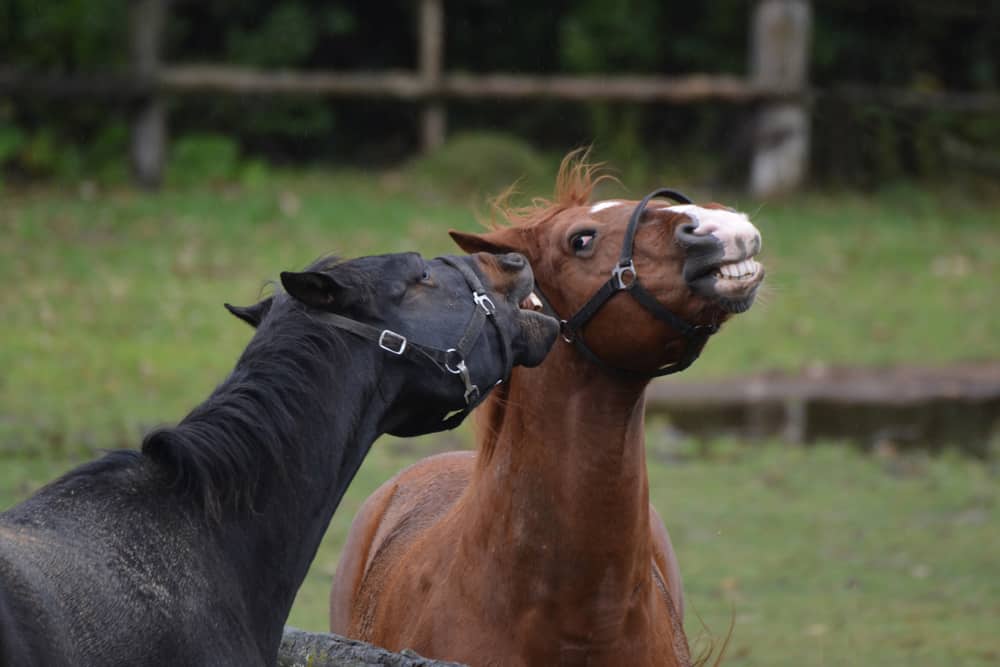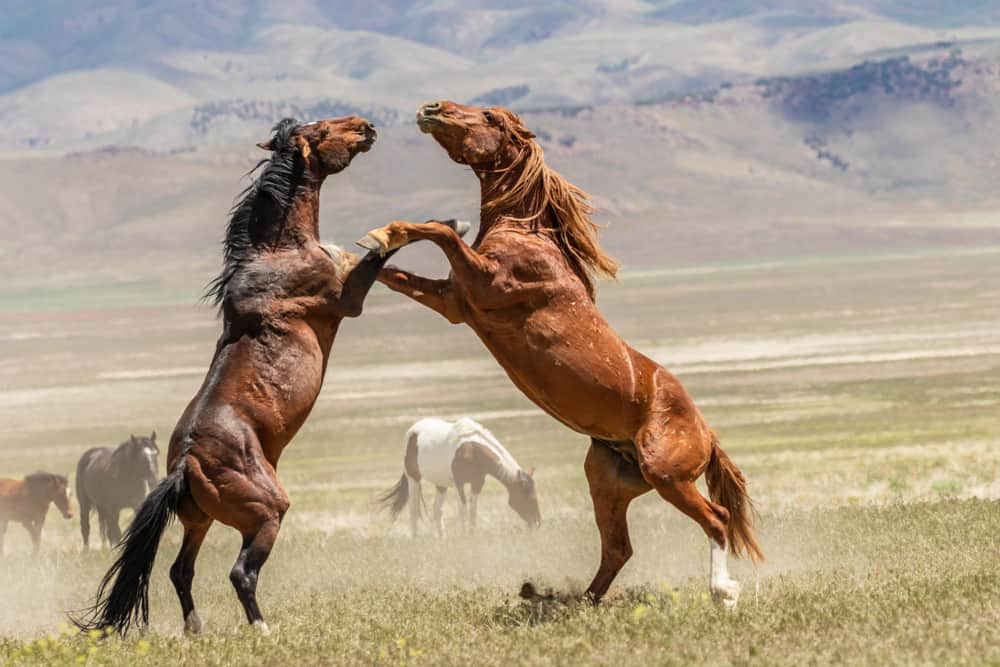
To understand why a horse is a bully, we first have to understand a bit more about horse behavior. What we perceive as bullying can be horses sorting out their hierarchy with natural herd behavior.
There are many effective ways to deal with a horse bully like:
- Ensuring the paddock size is adequate for all the horses
- Environment enrichment, and plenty of working exercise to reduce pent-up energy
- Placing extra food in another part of the paddock.
- Changing and rotating the horses he is turned out with
- Separating the bully from the rest of the horses
- Separating the bullied horse.
A horse that is a bully can wreak havoc on the other horses it lives with. Being a pasture bully, he can injure other horses by kicking, biting, and striking them. Bullies can run the other horses through fences and into other objects, causing injuries. A bully horse can also affect other horses’ health by keeping them from getting to the hay.
There are many factors to consider before concluding that your horse is a bully or if it’s being bullied. Let’s look at some behavioral issues that go along with bullying.
Understanding herd behavior what you need to know
Horses are very social herd animals that prefer living in a herd. There is a hierarchy or “pecking order” in every herd. There is always a leader. Their behavior is always hierarchical. The highest-ranking horse will eat and drink first. The lowest ranking horse will eat last and may not even get enough to eat. Once a dominance hierarchy is established, the leader will lead, and the rest will follow in rank.
Contrary to belief, the stallion in the herd is not just the sultan with a harem of mares. He also engages in herding and protective behavior. Stallions will stay on the periphery of the herd, where they will fight off other males and predators. When the herd travels, the stallion is almost always at the rear driving the straggling herd members forward and keeping the herd together.
The horse that tends to lead the herd is most certainly a dominant mare. Sometimes called the lead mare or boss mare. She will guide them to food and water and control the daily movement and routine of the herd.
This natural herd behavior occurs without effort in the wild. However, when we keep domesticated horses in a pasture and introduce new members into the group, it can most often upset the ranking order, and bullying could occur. The newly added horse needs to be accepted and establish his rank in the pasture herd.
Seeing a horse bully or being bullied can be very upsetting to owners. Aggression and bullying towards other horses are common behavioral problems most horse owners seek help with. Like with most other animals, aggression is normal and sometimes necessary to establish hierarchy. However, horses, in general, are not overly aggressive and usually live in harmony with each other.
Why do horses bully?
There are many reasons a horse might bully and behave aggressively. Here are a few examples:
- They could feel frightened or threatened due to a past traumatic experience. Horses forgive, but they don’t forget. Negative past experiences can have a lasting effect. Suffering an injury and pain during an experience with another horse can cause a horse to react out of fear of another incident and behave in an offense and guarded way.
- They could be in pain. Being in discomfort will make them less likely to accommodate other horses. Pain can change anyone’s behavior.
- Boredom. Horses are intelligent creatures that can get bored easily if kept in small enclosures or stalls for an extended period. While occasional boredom is considered normal, extensive boredom can cause drastic behavioral problems resulting in bullying.
- Establishing their rank in the herd. Horses will exert their dominance by controlling the movement of their peers. Horses will accept dominance when another horse causes them to move when they prefer not to do so and can easily be dominated.
- Being placed in artificial social groups. Your horse can’t choose who he is turned out within the paddock, and some horses just don’t get on.
- Inadequate early social development. Horses come from different upbringings, and some might have been taken away from their mothers at a too early age. If a foal is taken away too early and didn’t get the opportunity to learn proper social skills from an older horse, it might have learned some bad habits.
- Certain medical issues can lead to aggression. A vet check can quickly rule this out.
- Guarding resources. This is a common source of aggression in domestic horses. This happens when the horse seeks to control access to limited resources like water, food, breeding mates, or any number of valued things.

How to deal with a bullying horse
If you cannot easily identify the reason for the bullying, try the following tips.
- Ensure the paddock size is adequate and that it has plenty of space: the more space, the better.
- Environment enrichment and plenty of working exercise can reduce pent-up energy.
- Place extra food in another part of the paddock. When the bully chases a horse off the food, the other horse can then easily get access to food safely further away.
- Change and rotate the horses he is turned out with. Sometimes being turned out with a more dominant horse will help keep a bully in line.
- Separate the bully from the rest of the horses. Sectioning of a part of the paddock might be your only option if the bullying doesn’t stop. During this time, if the bullying horse tries to bully any other horse, he won’t be able to take any physical action. The fence in between will keep the other horses safe, and they will be able to just move out of the way. At the same time, it sends a signal to the bullying horse that his behavior is unrewarded and so he too will stop behaving aggressively. It is not a long-term solution, but it might help break the cycle of bullying behavior.
- Separate the bullied horse. If one horse is targeted all the time, you might want to consider separating that horse for the time being. Try keeping another horse with the bullied horse as a companion in a sectioned-off area next to the other horses. This will help the timid horse to deal with just one horse at a time and not the whole herd all at once. Allowing interaction across the fence while being safely on the other side helps introduce and slowly get the horse used to the rest of the herd.
Is biting normal behavior for horses, or is it also bullying?
Biting is normal behavior for horses. Some horses bite more than others for many different reasons. Horses have many ways of communicating, and biting is just one of them.
A gentle nip can show love or a harder, stronger bite trying to get another horse to move to bite aggressively in all forms of communication.
An aggressive edge can seriously hurt another horse so always take care when introducing a new horse to each other or into the herd. All of these bites, gentle or aggressive, sends a clear message, but all are considered normal behavior.
When a horse tries to bully bite a human
Horses bite humans for much the same reasons they bite each other. We are considered as part of their herd after all, and they are communicating with us too.
Some horses will nip you in a friendly way just saying hi, or they may nip you if you are standing where they don’t want you to stand politely asking you to move.
However, if a horse tries to bully and bite you out of aggression, it is best to nip that behavior in the bud directly.
When a horse tries to reach over to bite you, look straight ahead, not at the horse, and tap him lightly on the shin of his leg with your boot. This is just to create a surprise reaction and not pain. You want your horse to associate the bully bite’s effort with a distracting tap on his shin.
Horses are associative thinkers. Getting them to associate the thought of trying to bully bite with another part of his body, namely his leg, is a form of behavior modification. It is essential to be quick so that he associates the effort to bite with the tap directly. Just look ahead and act as if nothing happened, and you know and have seen nothing.
This will only take a few times, and then you’ll start to see as soon as the horse begins to bite, hesitate and look down at his leg. Keep doing this until the biting behavior stops.
Conclusion
We have established in this article that there could be several reasons why a horse becomes or acts like a bully. Identifying the underlying cause for this behavior will help us understand and find a solution to the problem. Remember that jostling for places in the herd hierarchy and showing dominance is natural horse behavior and will sort itself out in time.
